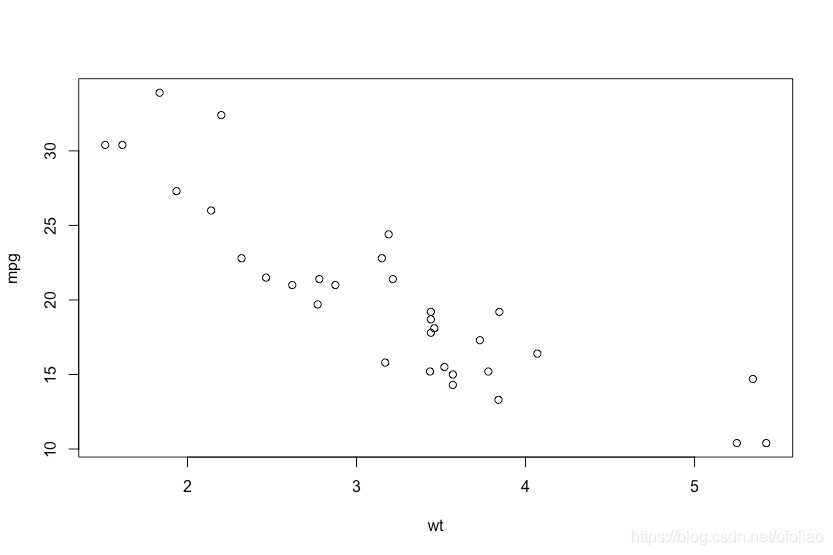面对一个陌生的R语言object,如何知道这个object有哪些属性、操作函数呢?
以R自带的mtcars数据集为例,看看lm函数返回的对象是什么东东:
plot(mpg~wt, data = mtcars)

> model <- lm(mpg~wt, data = mtcars)
> model
Call:
lm(formula = mpg ~ wt, data = mtcars)
Coefficients:
(Intercept) wt
37.285 -5.344
lm返回的拟合线性模型model到底是个什么东东涅?
是什么class
> class(model)
[1] "lm"
是什么mode和type
> mode(model)
[1] "list"
> typeof(model)
[1] "list"
有哪些attributes?
> names(model)
[1] "coefficients" "residuals" "effects" "rank"
[5] "fitted.values" "assign" "qr" "df.residual"
[9] "xlevels" "call" "terms" "model"
> attributes(model)
$names
[1] "coefficients" "residuals" "effects" "rank"
[5] "fitted.values" "assign" "qr" "df.residual"
[9] "xlevels" "call" "terms" "model"
$class
[1] "lm"
> str(model)
List of 12
$ coefficients : Named num [1:2] 37.29 -5.34
..- attr(*, "names")= chr [1:2] "(Intercept)" "wt"
$ residuals : Named num [1:32] -2.28 -0.92 -2.09 1.3 -0.2 ...
..- attr(*, "names")= chr [1:32] "Mazda RX4" "Mazda RX4 Wag" "Datsun 710" "Hornet 4 Drive" ...
$ effects : Named num [1:32] -113.65 -29.116 -1.661 1.631 0.111 ...
..- attr(*, "names")= chr [1:32] "(Intercept)" "wt" "" "" ...
$ rank : int 2
$ fitted.values: Named num [1:32] 23.3 21.9 24.9 20.1 18.9 ...
..- attr(*, "names")= chr [1:32] "Mazda RX4" "Mazda RX4 Wag" "Datsun 710" "Hornet 4 Drive" ...
$ assign : int [1:2] 0 1
$ qr :List of 5
..$ qr : num [1:32, 1:2] -5.657 0.177 0.177 0.177 0.177 ...
.. ..- attr(*, "dimnames")=List of 2
.. .. ..$ : chr [1:32] "Mazda RX4" "Mazda RX4 Wag" "Datsun 710" "Hornet 4 Drive" ...
.. .. ..$ : chr [1:2] "(Intercept)" "wt"
.. ..- attr(*, "assign")= int [1:2] 0 1
..$ qraux: num [1:2] 1.18 1.05
..$ pivot: int [1:2] 1 2
..$ tol : num 1e-07
..$ rank : int 2
..- attr(*, "class")= chr "qr"
$ df.residual : int 30
$ xlevels : Named list()
$ call : language lm(formula = mpg ~ wt, data = mtcars)
$ terms :Classes 'terms', 'formula' language mpg ~ wt
.. ..- attr(*, "variables")= language list(mpg, wt)
.. ..- attr(*, "factors")= int [1:2, 1] 0 1
.. .. ..- attr(*, "dimnames")=List of 2
.. .. .. ..$ : chr [1:2] "mpg" "wt"
.. .. .. ..$ : chr "wt"
.. ..- attr(*, "term.labels")= chr "wt"
.. ..- attr(*, "order")= int 1
.. ..- attr(*, "intercept")= int 1
.. ..- attr(*, "response")= int 1
.. ..- attr(*, ".Environment")=<environment: R_GlobalEnv>
.. ..- attr(*, "predvars")= language list(mpg, wt)
.. ..- attr(*, "dataClasses")= Named chr [1:2] "numeric" "numeric"
.. .. ..- attr(*, "names")= chr [1:2] "mpg" "wt"
$ model :'data.frame': 32 obs. of 2 variables:
..$ mpg: num [1:32] 21 21 22.8 21.4 18.7 18.1 14.3 24.4 22.8 19.2 ...
..$ wt : num [1:32] 2.62 2.88 2.32 3.21 3.44 ...
..- attr(*, "terms")=Classes 'terms', 'formula' language mpg ~ wt
.. .. ..- attr(*, "variables")= language list(mpg, wt)
.. .. ..- attr(*, "factors")= int [1:2, 1] 0 1
.. .. .. ..- attr(*, "dimnames")=List of 2
.. .. .. .. ..$ : chr [1:2] "mpg" "wt"
.. .. .. .. ..$ : chr "wt"
.. .. ..- attr(*, "term.labels")= chr "wt"
.. .. ..- attr(*, "order")= int 1
.. .. ..- attr(*, "intercept")= int 1
.. .. ..- attr(*, "response")= int 1
.. .. ..- attr(*, ".Environment")=<environment: R_GlobalEnv>
.. .. ..- attr(*, "predvars")= language list(mpg, wt)
.. .. ..- attr(*, "dataClasses")= Named chr [1:2] "numeric" "numeric"
.. .. .. ..- attr(*, "names")= chr [1:2] "mpg" "wt"
- attr(*, "class")= chr "lm"
有哪些methods?
知道了model属于哪个class,可以调用methods查看该class定义了哪些generic functions:
> methods(class = "lm")
[1] add1 alias anova case.names
[5] coerce confint cooks.distance deviance
[9] dfbeta dfbetas drop1 dummy.coef
[13] effects extractAIC family formula
[17] hatvalues influence initialize kappa
[21] labels logLik model.frame model.matrix
[25] nobs plot predict print
[29] proj qr residuals rstandard
[33] rstudent show simulate slotsFromS3
[37] summary variable.names vcov





 本文通过实例解析R语言中lm函数返回对象的属性与方法,包括其class、mode、type、attributes及可用的methods,帮助理解线性模型的内部结构。
本文通过实例解析R语言中lm函数返回对象的属性与方法,包括其class、mode、type、attributes及可用的methods,帮助理解线性模型的内部结构。
















 30
30

 被折叠的 条评论
为什么被折叠?
被折叠的 条评论
为什么被折叠?








